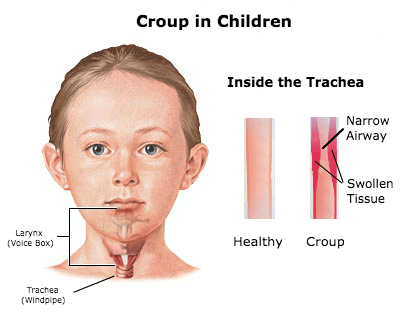What is Croup in Children and Babies?
Croup refers to the inflammation and narrowing of the upper parts of the air passages that lead into the lungs, interfering with breathing. Younger children are at greater risk because their airways are small and more pliable, and the slightest swelling can lead to obstruction of breathing. Crying or anxiety may further worsen the symptoms.
In children younger than three years, croup most commonly takes the form of laryngotracheobronchitis, an inflammation involving both the upper and lower respiratory tracts. This inflammation usually starts in the upper airways and descends to the lungs. In older children, only the voice box or the windpipe may be affected.
In its most severe form, croup is a manifestation of epiglottitis, or inflammation of the tissue flap that closes off the windpipe. Epiglottitis is a true medical emergency, since it completely blocks off the child’s airways.
Signs and Symptoms of Croup in Children
A mild infection of the upper airways is usually the first stage in all kinds of croup. Symptoms develop gradually, and there may be a mild or high fever. Children are restless and complain of pain during coughing.
In spasmodic croup, by contrast, there is no fever, and symptoms develop suddenly, usually at night. The child may wake up with breathing difficulty and have a sudden bout of coughing. Croup is more common in the winter months but can occur at any time during the year.
Common Causes of Croup
Croup usually is caused by viruses and less commonly caused by bacteria. Respiratory allergies may set the stage for the infection. The viruses that cause croup are as varied as those responsible for the common cold and influenza; therefore, one episode of croup does not give a child protection against another.
Seeking Medical Advice
Even though croup is usually mild and disappears rather quickly, may also indicate the presence of a very serious respiratory tract infection (see epiglottitis). The symptoms of croup are similar to those of bacterial epiglottitis which is a true medical emergency.
If your child has a croupy (barking) cough, is unable to speak, is leaning forward, is pale, has noise coming through the windpipe on each breath, and/or is drooling, it is essential to seek urgent medical asssitance.
Symptoms of uncomplicated croup usually get worse at night and wane during the day, but they generally clear within three to seven days. If the disorder lasts longer, an underlying problem— malformation of the airways, bacterial infection or a foreign body lodged in the air passages—may be interfering with the healing process.
Treatment for Croup
Children with croup may require oxygen and medications to help open the airways. Very rarely, children may need temporary placement of a breathing tube to bypass the obstruction. The tube usually is removed within a day or two. A breathing tube, along with antibiotic therapy, is necessary in cases of epiglottitis. Because croup is caused by a virus, it is not treated with antibiotics.
One traditional component of treatment is maintaining moisture in the atmosphere because inflammation and swelling cause the mucous lining of the airways to dry out, which creates further breathing difficulties.






